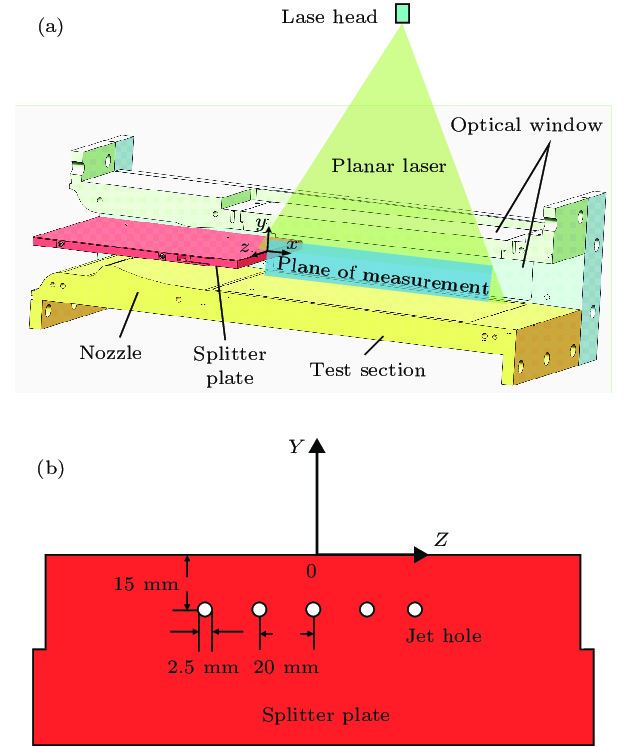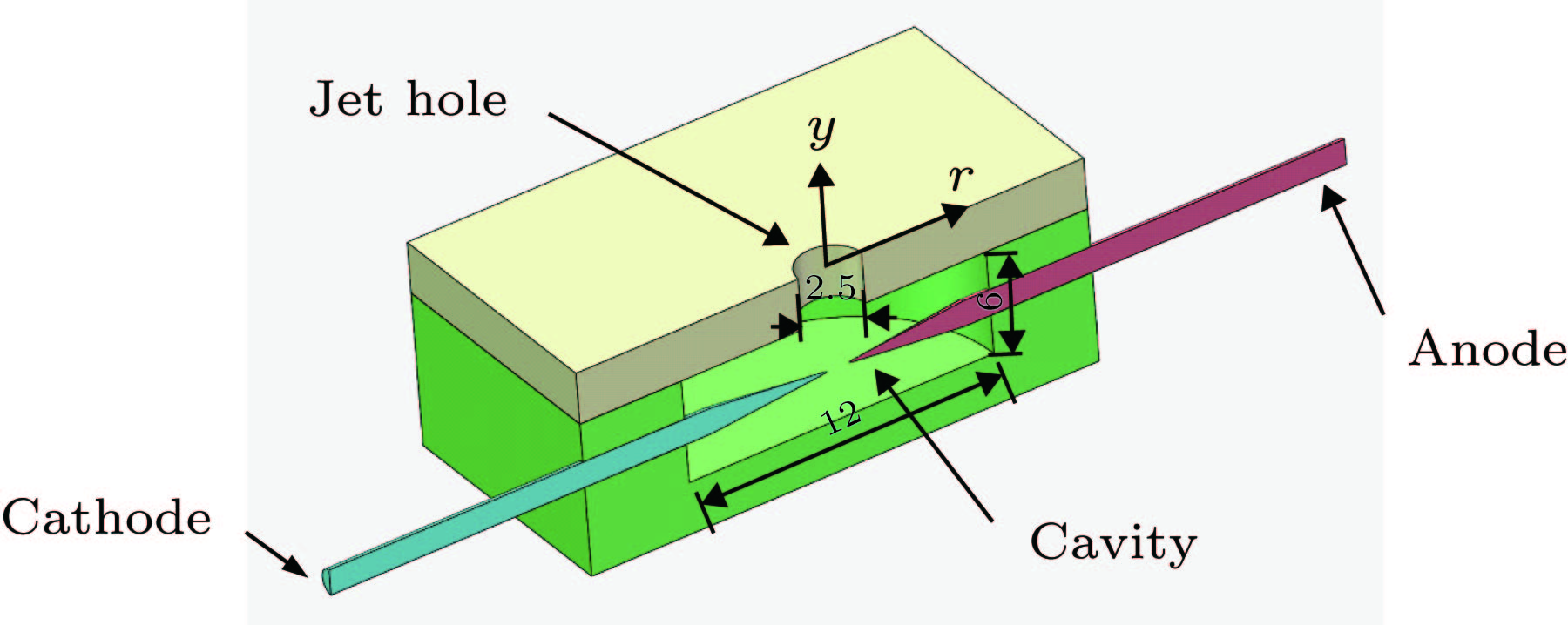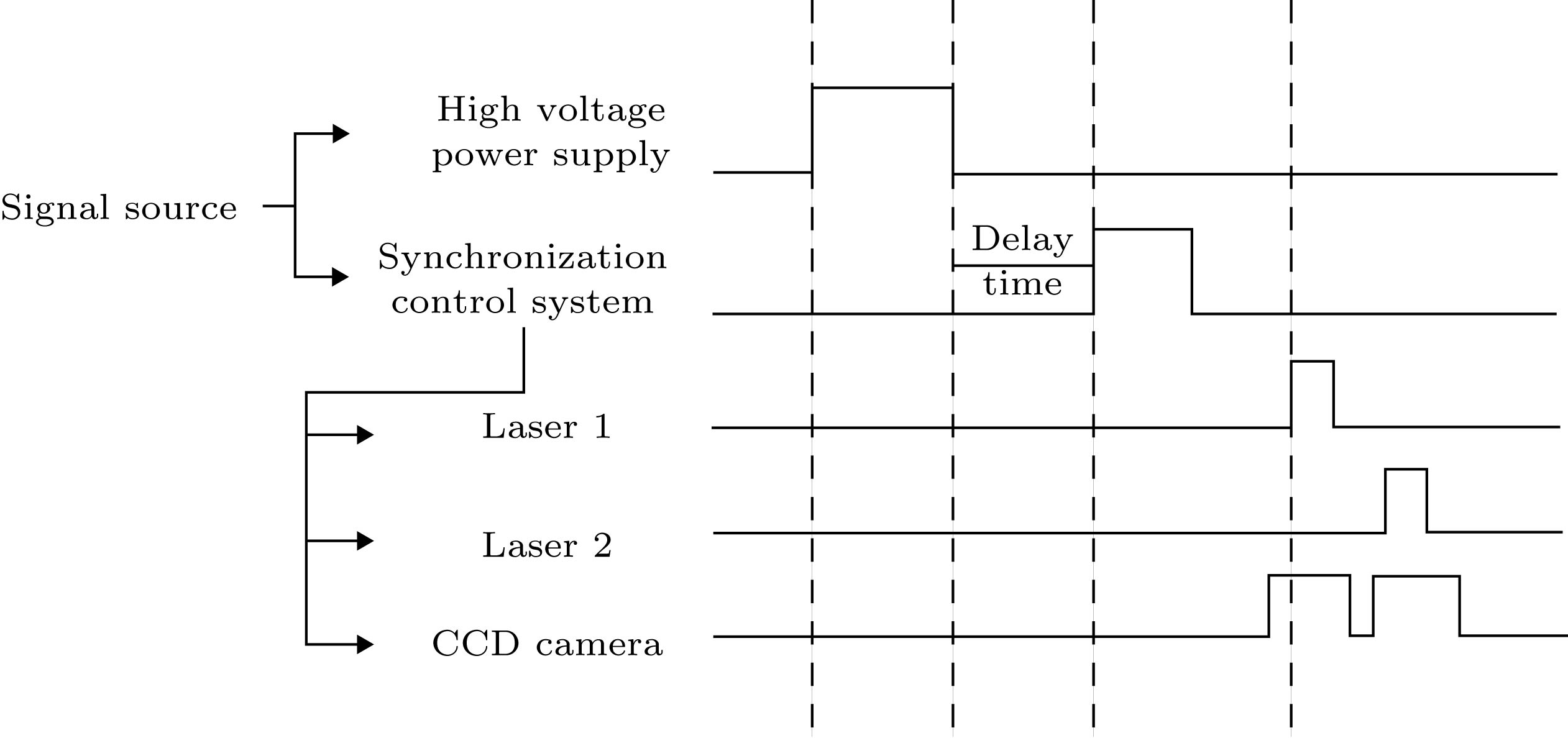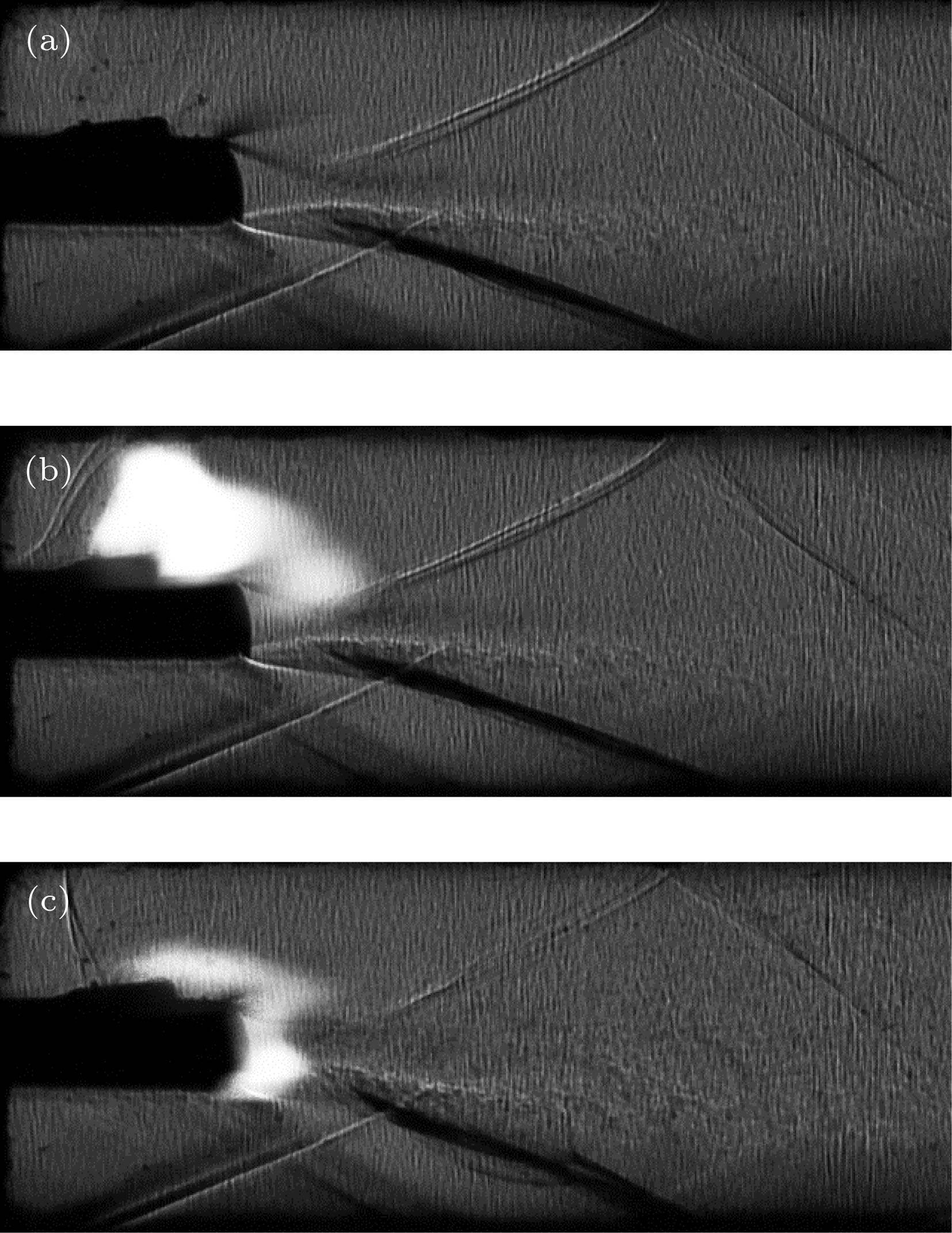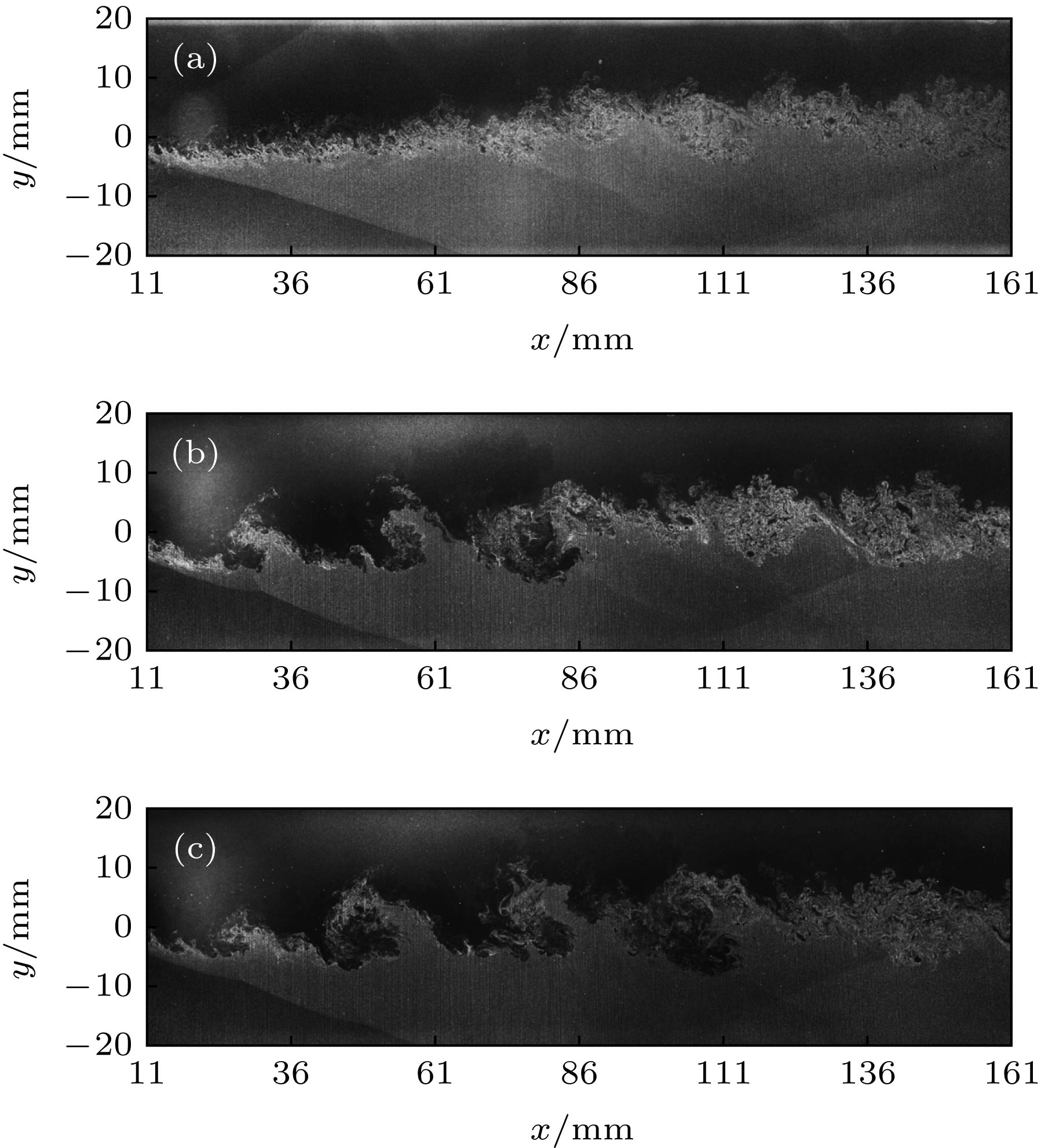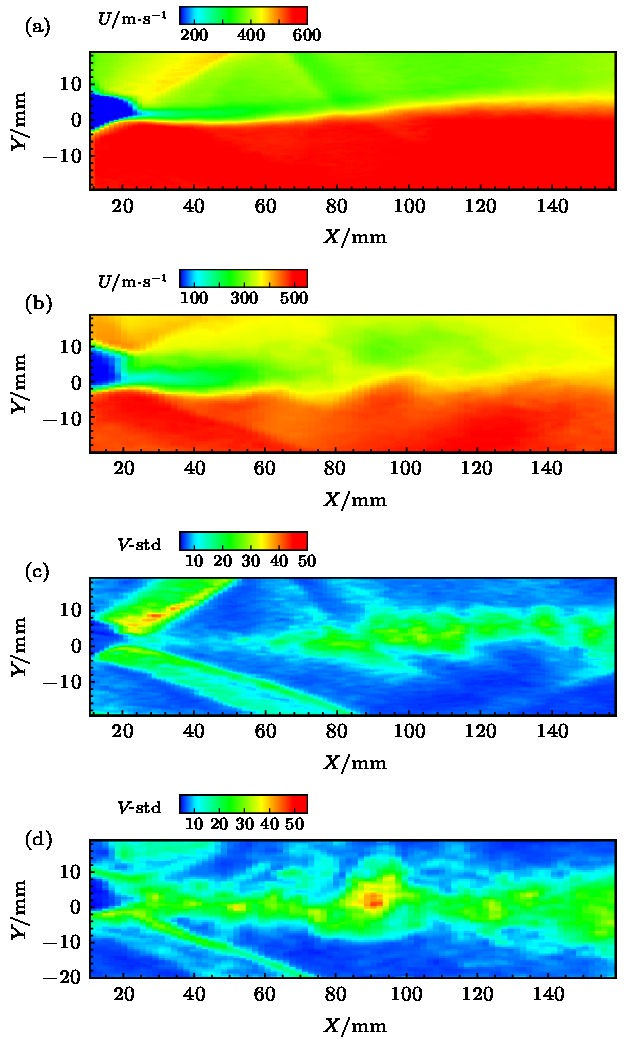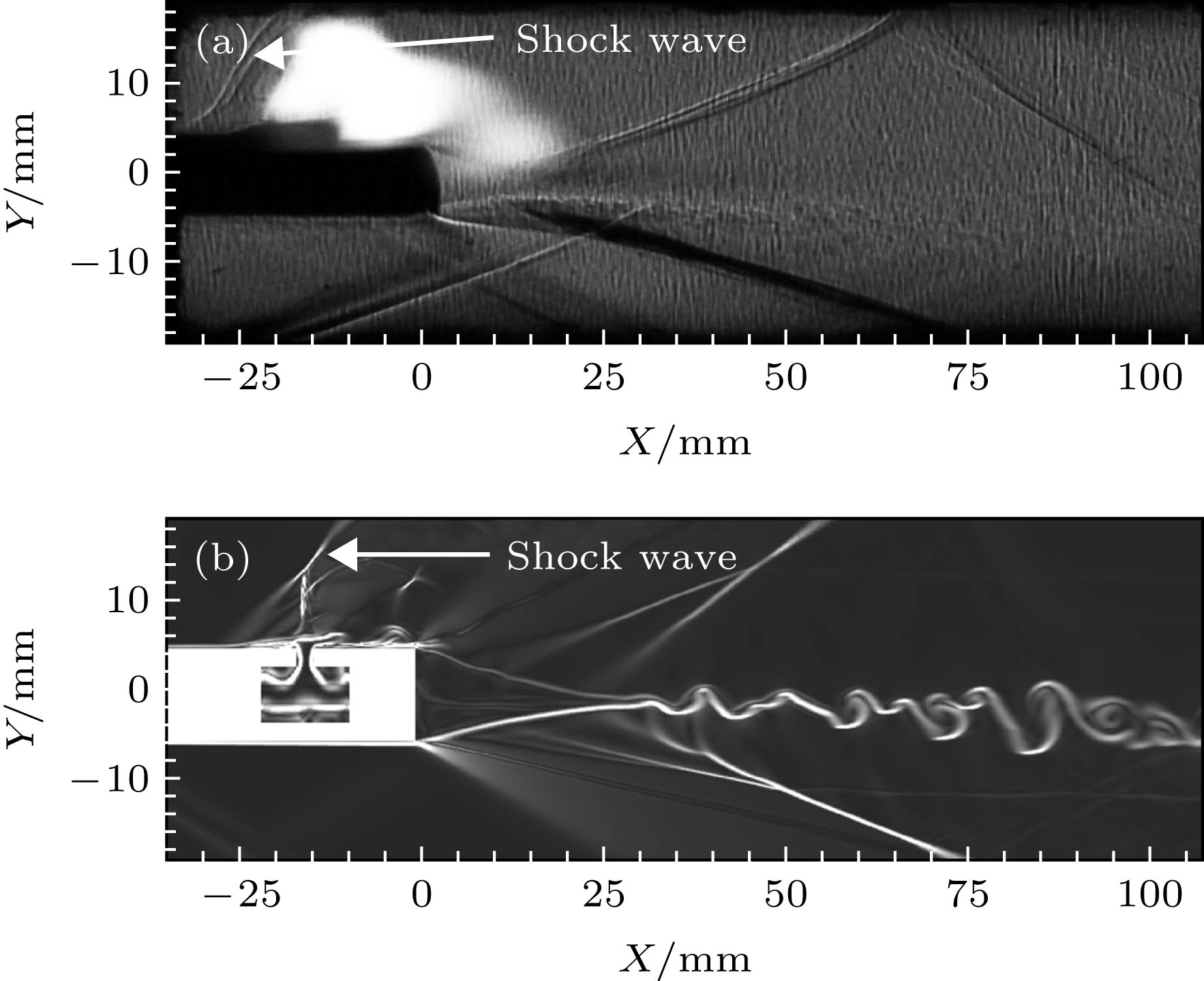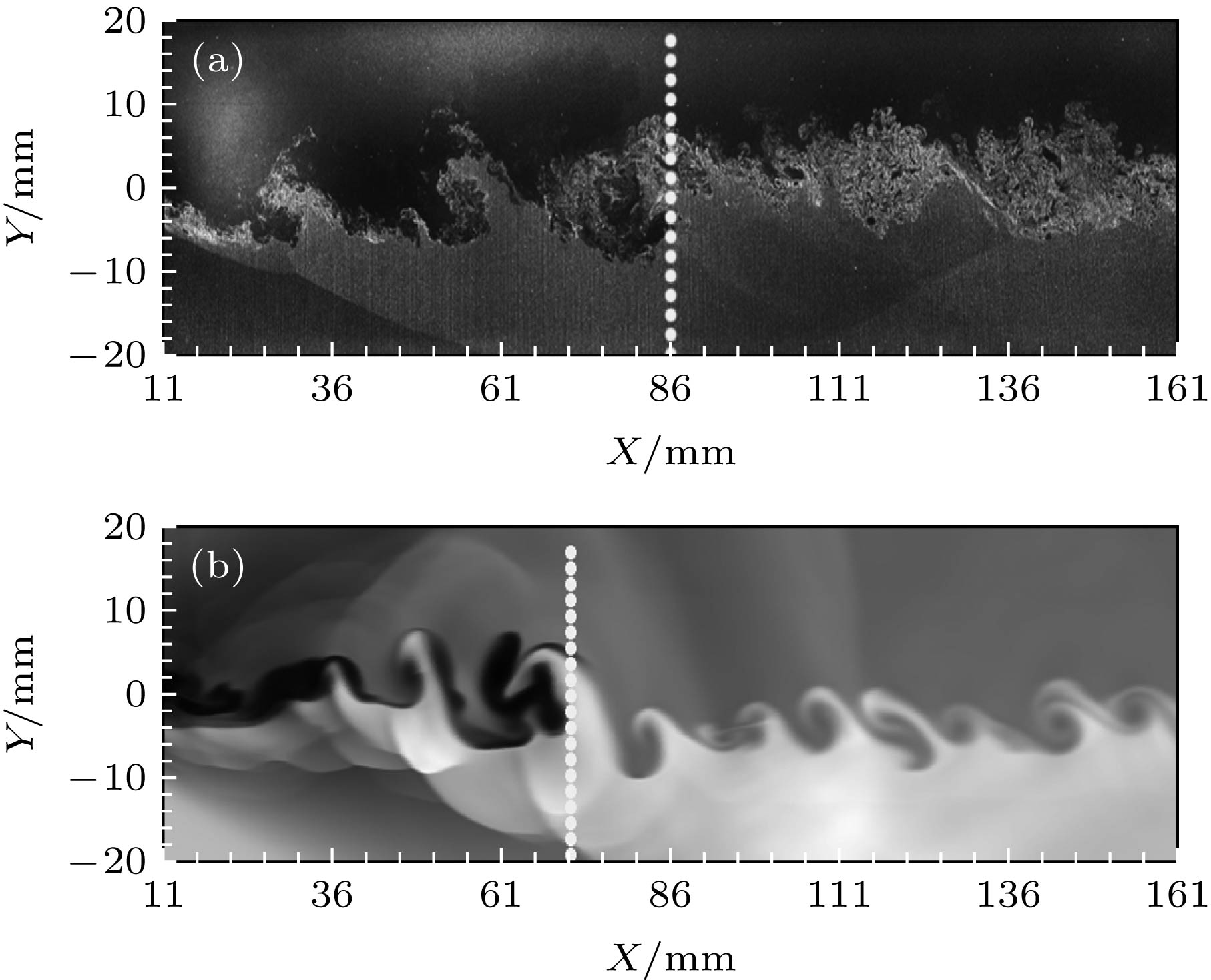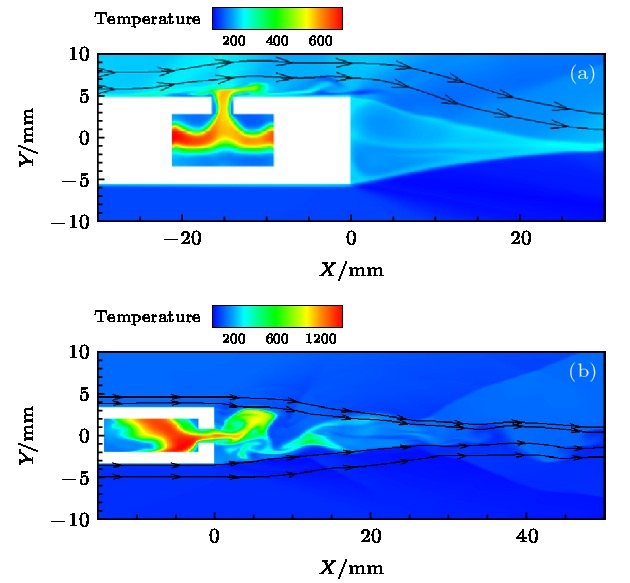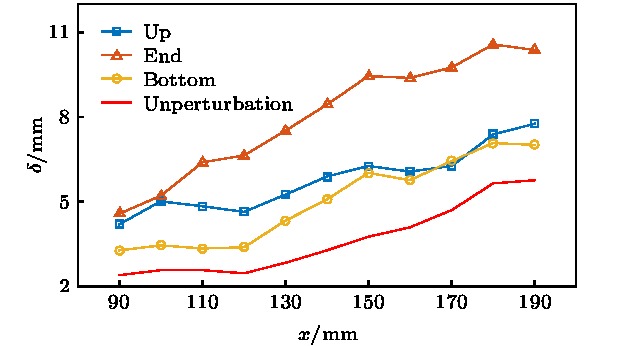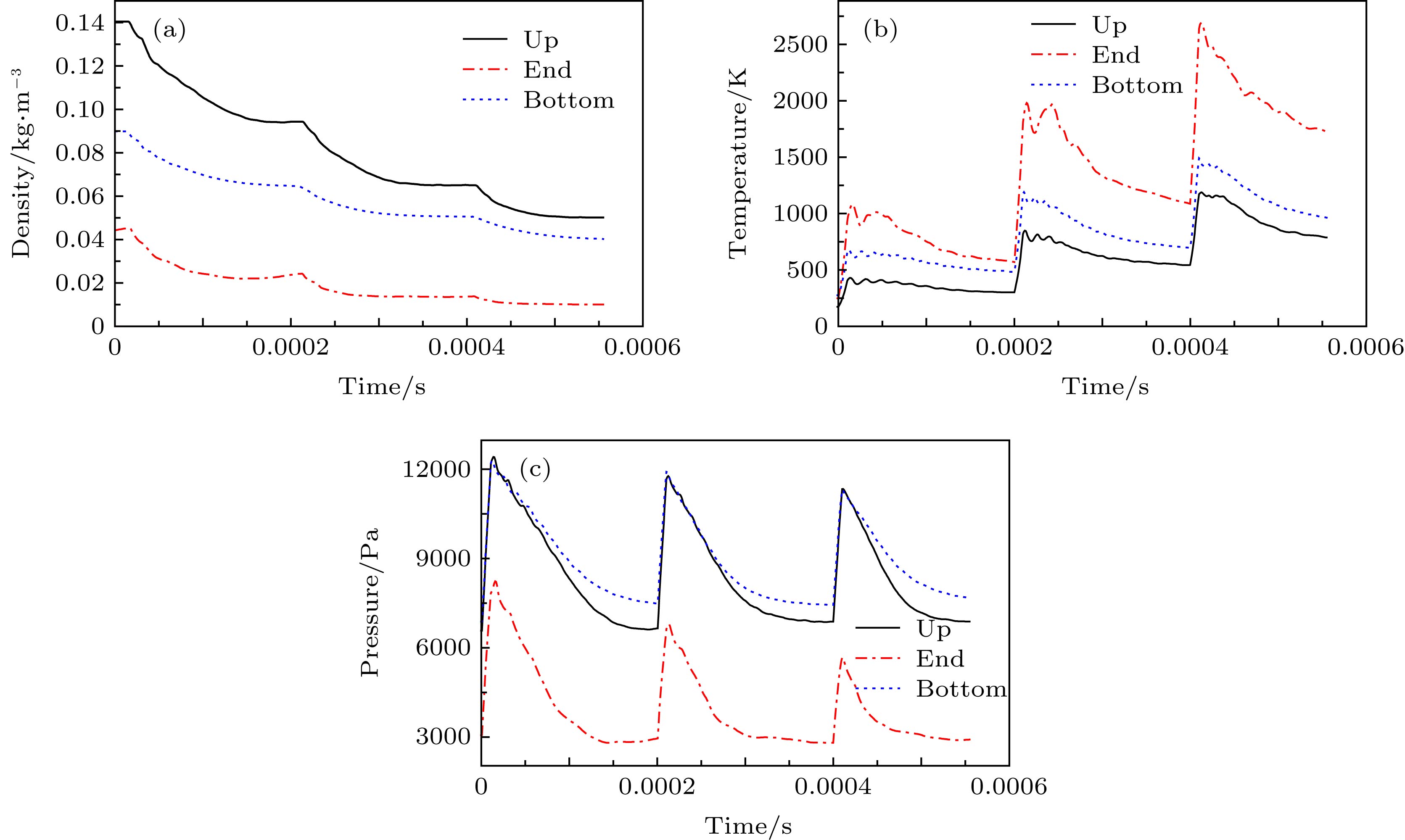-
采用实验加仿真方法研究了等离子体合成射流对超声速混合层的影响. 使用基于纳米粒子的平面激光散射技术(nanoparticle-based planar laser scattering, NPLS)、粒子图像测速技术 (particle image velocimetry, PIV)以及纹影手段获取了单次脉冲对混合层的影响. 采用二维数值仿真对布置在不同位置的高频激励器的混合效果以及激励器的性能进行了研究. 通过对比有扰动和无扰动的NPLS、PIV以及纹影实验结果, 发现等离子体合成射流对超声速混合层有明显的扰动, 射流喷出时会产生较强的斜激波. 对数值仿真结果的分析表明, 等离子体合成射流可以有效地增强混合层的厚度. 对比激励器布置在不同位置工况下的混合层厚度, 可以看出在激励器隔板末端对混合层的扰动效果最好, 混合层对在隔板末端的激励器扰动响应也是最快的. 对等离子体合成射流激励器的性能分析表明, 在隔板末端的激励器输出的能量最多. 通过分析等离子体合成射流的作用过程, 可以看出激励器在隔板上下表面布置的作用形式是通过作用来流进而影响混合层, 在隔板尾端布置的等离子体合成射流激励器直接作用在混合层上, 实现混合增强.Mixing enhancement for supersonic mixing layer is of great importance for developing scramjet engine. The growth rate of supersonic mixing layer is smaller than that of subsonic mixing layer. As the compressibility increases, the mixing enhancement becomes more difficult. Plasma synthetic jet is regarded as a promising flow control technology. The plasma synthetic jet generator can produce high energy jet. This generator has no moving parts and does not need additional gas source. It is the first time that plasma synthetic jet has been used to enhance the mixing in supersonic mixing layers. The influence of plasma synthetic jet on the supersonic mixing layer is investigated experimentally and numerically. The experiments are conducted in the low noise supersonic mixing layer wind tunnel. The Mach number of upper stream and lower stream are 1.37 and 2.39 respectively. The convective Mach number of this wind tunnel is 0.32. The plasma synthetic jet actuators are installed in the splitter plate. The distance between the jet hole and the splitter plate end is 15 mm. The nanoparticle-based planar laser scattering (NPLS), particle image velocimetry (PIV) and schlieren are used to obtain the response of the supersonic mixing layer to single pulse plasma synthetic jet perturbation. The NPLS successfully captures the large-scaled vortex structures induced by the plasma synthetic jet in the supersonic mixing layers. The effect of plasma synthetic jet is remarkable. The schlieren images show the process of the perturbation. An oblique shock wave is generated when the jet is ejected. The PIV is employed to obtain the influence of plasma synthetic jet on the velocity field. The y-velocity standard deviation increases due to the perturbation. The actuators’ mixing enhancement effects and actuators’ performances at three locations are investigated by two-dimensional numerical simulation. The three actuators are located on the upper, bottom and end surface of splitter plate respectively. The numerical simulation results show that the mixing layer thickness is increased by the plasma synthetic jet perturbation. There are two mechanisms of perturbations while actuators are located at different positions. The actuators installed on the upper and bottom surface of splitter plate influence the mixing layer through perturbing the upper and lower stream respectively. The actuator installed at the end of splitter plate affects the mixing layer directly. The response time of supersonic mixing layers to the perturbation of the actuator installed at the end of splitter plate is shorter than those of the others. The performance of each actuator is sensitive to the location.
-
Keywords:
- mixing enhancement /
- plasma synthetic jet /
- flow control /
- supersonic mixing layers
[1] Zang A, Tempel T, Yu K, Buckley S 2005 43rd AIAA Aerospace Sciences Meeting and Exhibit Reno, Nevada, 10−13 January, 2005 p1423
[2] Gutmark E J, Schadow C S, Yu K H 1995 Annu. Rev. Fluid Mech. 27 375
 Google Scholar
Google Scholar
[3] Zhang C X, Liu Y, Fu B S, Yu X J 2018 Acta Astronaut. 153 50
 Google Scholar
Google Scholar
[4] Haimovitch Y, Gartenberg E, Roberts J A, Northam G 1994 30th Joint Propulsion Conference and Exhibit Indianapolis, IN, 27−29 June, 1994 p2940
[5] Guirguis R, Grinstein F, Young T, Oran E, Kailasanath K 1987 25th AIAA Aerospace Sciences Meeting Reno, Nevada, 12−15 January, 1987 p0373
[6] Seiner J M, Dash S M, Kenzakowski D C 2001 J. Propul. Power 17 1273
 Google Scholar
Google Scholar
[7] Collin E, Barre S, Bonnet J P 2004 Phys. Fluids 16 765
 Google Scholar
Google Scholar
[8] Fernando E M, Menon S 1993 AIAA J. 31 278
 Google Scholar
Google Scholar
[9] Kharitonov A, Lokotko A, Tchernyshyev A, Kopchenov V, Lomkov K, Rudakov A 2000 38th Aerospace Sciences Meeting and Exhibit Reno, Nevada, 10−13 January, 2000 p0559
[10] Freeman A P, Catrakis H J 2009 J. Turbul. 10 1
 Google Scholar
Google Scholar
[11] Adelgren R G, Elliott G S, Crawford J B, Carter C D, Donbar J M, Grosjean D F 2005 AIAA J. 43 776
 Google Scholar
Google Scholar
[12] Zhang D, Tan J, Liang L 2015 Acta Astronaut. 117 440
 Google Scholar
Google Scholar
[13] Narayanaswamy V, Shin J, Clemens N, Raja L 2008 46th AIAA Aerospace Sciences Meeting and Exhibit Reno, Nevada, January 7−10, 2008 p285
[14] Grossman K, Bohdan C, van Wie D 2003 41st Aerospace Sciences Meeting and Exhibit Reno, Nevada, January 6−9 , 2003 p57
[15] Grossman K, Cybyk B, van Wie D, Rigling M 2004 42nd AIAA Aerospace Sciences Meeting and Exhibit Reno, Nevada, January 5−8 , 2004 p89
[16] 王林, 夏智勋, 罗振兵, 周岩, 张宇 2014 物理学报 63 194702
 Google Scholar
Google Scholar
Wang L, Xia Z X, Luo Z B, Zhou Y, Zhang Y 2014 Acta Phys. Sin. 63 194702
 Google Scholar
Google Scholar
[17] Narayanaswamy V, Raja L L, Clemens N T 2012 Phys. Fluids 24 076101
 Google Scholar
Google Scholar
[18] Zhou Y, Xia Z X, Luo Z B, Wang L 2016 Sci. China Technol. Sc. 60 146
[19] 王宏宇, 李军, 金迪, 代辉, 甘甜, 吴云 2017 物理学报 66 084705
 Google Scholar
Google Scholar
Wang H Y, Li J, Jin D, Dai H, Can T, Wu Y 2017 Acta Phys. Sin. 66 084705
 Google Scholar
Google Scholar
[20] Hardy P, Barricau P, Caruana D, Gleyzes C, Belinger A, Cambronne J P 2010 40th Fluid Dynamics Conference and Exhibit Chicago, Illinois, 28 June−1 July, 2010 p5103
[21] Huet M 2014 20th AIAA/CEAS Aeroacoustics Conference Atlanta, GA, June 16−20 , 2014 p2620
[22] Chedevergne F, Léon O, Bodoc V, Caruana D 2015 Int. J. Heat Fluid Fl. 56 1
 Google Scholar
Google Scholar
[23] Bogdanoff D W 1983 AIAA J. 21 926
 Google Scholar
Google Scholar
[24] Papamoschou D 1991 AIAA J. 29 680
[25] Arvind S, Jamey D J 2007 J. Phys. D: Appl. Phys. 40 637
 Google Scholar
Google Scholar
[26] Zhou Y, Xia Z X, Luo Z B, Wang L, Deng X 2017 Acta Astronaut. 133 95
 Google Scholar
Google Scholar
[27] Haack S, Taylor T, Z. Cybyk B, H. Foster C, Alvi F 2011 42nd AIAA Plasmadynamics and Lasers Conference Honolulu, Hawaii, 27−30 June, 2011 p3997
[28] 赵玉新 2008 博士学位论文(长沙: 国防科技大学)
Zhao Y X 2008 Ph. D. Dissertation (Changsha: National University of Defense Technology) (in Chinese)
[29] 罗振兵 2006 博士学位论文(长沙: 国防科技大学)
Luo Z B 2006 Ph. D. Dissertation (Changsha: National University of Defense Technology) (in Chinese)
[30] Narayanaswamy V, Raja L L, Clemens N T 2010 AIAA J. 48 297
 Google Scholar
Google Scholar
[31] Freeman L J 2014 Master Thesis (California Polytechnic State University)
[32] 周岩 2018 博士学位论文 (长沙: 国防科技大学)
Zhou Y 2018 Ph. D. Dissertation (Changsha: National University of Defense Technology) (in Chinese)
-
图 15 (T0 + 555 μs)时刻密度场 (a) 未受扰动; (b) 激励器在隔板上表面; (c) 激励器在隔板尾端; (d) 激励器在隔板下表面
Fig. 15. Contours of density at T0 + 555 μs: (a) Unperturbation; (b) the actuator at the upper surface of the splitter plate; (c) the actuator at the end surface of the splitter plate; (d) the actuator at the bottom surface of the splitter plate.
表 1 压力匹配情况下校测流场参数
Table 1. Flow parameters of supersonic mixing layer.
马赫数Ma 速度U/m·s–1 静温T/K 总温T0/K 运动黏度μ/
10–5 m2·s–11.37 405.16 218.39 300 1.4312 2.39 567.18 139.87 300 0.9635 -
[1] Zang A, Tempel T, Yu K, Buckley S 2005 43rd AIAA Aerospace Sciences Meeting and Exhibit Reno, Nevada, 10−13 January, 2005 p1423
[2] Gutmark E J, Schadow C S, Yu K H 1995 Annu. Rev. Fluid Mech. 27 375
 Google Scholar
Google Scholar
[3] Zhang C X, Liu Y, Fu B S, Yu X J 2018 Acta Astronaut. 153 50
 Google Scholar
Google Scholar
[4] Haimovitch Y, Gartenberg E, Roberts J A, Northam G 1994 30th Joint Propulsion Conference and Exhibit Indianapolis, IN, 27−29 June, 1994 p2940
[5] Guirguis R, Grinstein F, Young T, Oran E, Kailasanath K 1987 25th AIAA Aerospace Sciences Meeting Reno, Nevada, 12−15 January, 1987 p0373
[6] Seiner J M, Dash S M, Kenzakowski D C 2001 J. Propul. Power 17 1273
 Google Scholar
Google Scholar
[7] Collin E, Barre S, Bonnet J P 2004 Phys. Fluids 16 765
 Google Scholar
Google Scholar
[8] Fernando E M, Menon S 1993 AIAA J. 31 278
 Google Scholar
Google Scholar
[9] Kharitonov A, Lokotko A, Tchernyshyev A, Kopchenov V, Lomkov K, Rudakov A 2000 38th Aerospace Sciences Meeting and Exhibit Reno, Nevada, 10−13 January, 2000 p0559
[10] Freeman A P, Catrakis H J 2009 J. Turbul. 10 1
 Google Scholar
Google Scholar
[11] Adelgren R G, Elliott G S, Crawford J B, Carter C D, Donbar J M, Grosjean D F 2005 AIAA J. 43 776
 Google Scholar
Google Scholar
[12] Zhang D, Tan J, Liang L 2015 Acta Astronaut. 117 440
 Google Scholar
Google Scholar
[13] Narayanaswamy V, Shin J, Clemens N, Raja L 2008 46th AIAA Aerospace Sciences Meeting and Exhibit Reno, Nevada, January 7−10, 2008 p285
[14] Grossman K, Bohdan C, van Wie D 2003 41st Aerospace Sciences Meeting and Exhibit Reno, Nevada, January 6−9 , 2003 p57
[15] Grossman K, Cybyk B, van Wie D, Rigling M 2004 42nd AIAA Aerospace Sciences Meeting and Exhibit Reno, Nevada, January 5−8 , 2004 p89
[16] 王林, 夏智勋, 罗振兵, 周岩, 张宇 2014 物理学报 63 194702
 Google Scholar
Google Scholar
Wang L, Xia Z X, Luo Z B, Zhou Y, Zhang Y 2014 Acta Phys. Sin. 63 194702
 Google Scholar
Google Scholar
[17] Narayanaswamy V, Raja L L, Clemens N T 2012 Phys. Fluids 24 076101
 Google Scholar
Google Scholar
[18] Zhou Y, Xia Z X, Luo Z B, Wang L 2016 Sci. China Technol. Sc. 60 146
[19] 王宏宇, 李军, 金迪, 代辉, 甘甜, 吴云 2017 物理学报 66 084705
 Google Scholar
Google Scholar
Wang H Y, Li J, Jin D, Dai H, Can T, Wu Y 2017 Acta Phys. Sin. 66 084705
 Google Scholar
Google Scholar
[20] Hardy P, Barricau P, Caruana D, Gleyzes C, Belinger A, Cambronne J P 2010 40th Fluid Dynamics Conference and Exhibit Chicago, Illinois, 28 June−1 July, 2010 p5103
[21] Huet M 2014 20th AIAA/CEAS Aeroacoustics Conference Atlanta, GA, June 16−20 , 2014 p2620
[22] Chedevergne F, Léon O, Bodoc V, Caruana D 2015 Int. J. Heat Fluid Fl. 56 1
 Google Scholar
Google Scholar
[23] Bogdanoff D W 1983 AIAA J. 21 926
 Google Scholar
Google Scholar
[24] Papamoschou D 1991 AIAA J. 29 680
[25] Arvind S, Jamey D J 2007 J. Phys. D: Appl. Phys. 40 637
 Google Scholar
Google Scholar
[26] Zhou Y, Xia Z X, Luo Z B, Wang L, Deng X 2017 Acta Astronaut. 133 95
 Google Scholar
Google Scholar
[27] Haack S, Taylor T, Z. Cybyk B, H. Foster C, Alvi F 2011 42nd AIAA Plasmadynamics and Lasers Conference Honolulu, Hawaii, 27−30 June, 2011 p3997
[28] 赵玉新 2008 博士学位论文(长沙: 国防科技大学)
Zhao Y X 2008 Ph. D. Dissertation (Changsha: National University of Defense Technology) (in Chinese)
[29] 罗振兵 2006 博士学位论文(长沙: 国防科技大学)
Luo Z B 2006 Ph. D. Dissertation (Changsha: National University of Defense Technology) (in Chinese)
[30] Narayanaswamy V, Raja L L, Clemens N T 2010 AIAA J. 48 297
 Google Scholar
Google Scholar
[31] Freeman L J 2014 Master Thesis (California Polytechnic State University)
[32] 周岩 2018 博士学位论文 (长沙: 国防科技大学)
Zhou Y 2018 Ph. D. Dissertation (Changsha: National University of Defense Technology) (in Chinese)
计量
- 文章访问数: 15291
- PDF下载量: 103
- 被引次数: 0














 下载:
下载:

